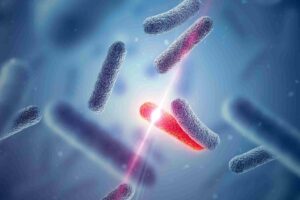What is already known on this topic
Microglia are a group of non-neuronal cells that act as the first line of immune defense in the brain. During aging, the function of microglia declines — maybe as a result of altered interactions between the brain and other body sites. These interactions appear to be mediated by various factors, including the gut microbiota, which signals along the microbiota-gut-brain axis.
What this research adds
Working in mice, researchers found that the gut microbiota influences aging-associated changes in microglial gene expression. In germ-free animals, the gut microbiota produced less ROS, or reactive oxygen species — a type of chemicals that can cause damage to the cell’s basic building blocks. Gut microbes were also associated with microglia accumulating more defective mitochondria — the cell’s powerhouses. Analyses of blood and brain tissue revealed that microglia in the aging brain accumulate a molecule called N6-carboxymethyllysine (CML). The accumulation of CML in the aging microglia appeared to be microbiota-dependent, and CML levels also rose in the blood and brains of aging humans.
Conclusions
The findings suggest that gut microbes regulate specific features of microglia during aging.
Microglia — a type of immune cells found in the brain — constantly scavenge the organ for plaques, damaged neurons and infectious agents. But the scavenging function of microglia deteriorates as the brain gets older, concomitant with cognitive decline. New research done in mice shows that gut microbes may contribute to damage microglia during aging.
The findings, published in Nature Neuroscience, suggest that the gut microbiota, which changes in composition with age, can increase intestinal permeability, allowing potentially harmful metabolites to reach the brain and hinder specific features of microglia.
Microglia act as the first line of immune defense in the brain. Scientists have known that during aging, the function of microglia declines — maybe as a result of altered interactions between the brain and other body sites. These interactions appear to be mediated by various factors, including the gut microbiota, which signals along the microbiota-gut-brain axis.
To investigate how gut microbes influence microglial aging, Thomas Blank at the University of Freiburg and his colleagues analyzed microglia from old and young-adult mice raised with or without microbes.
Microglial signature
By assessing the gene expression in the mice’s microglia, the researchers identified a specific genetic signature that regulates central processes in microglia. The microglial signature of germ-free mice was different from that of mice raised with microbes. These differences were particularly pronounced in aging mice, the researchers found.
Next, the team set out to probe whether these differences were also present at the cellular level. In germ-free animals, the gut microbiota produced less ROS, or reactive oxygen species — a type of chemicals that can cause damage to the cell’s basic building blocks such as DNA and proteins.
Mice raised in the presence of gut microbes also had more defects in their mitochondria — the cell’s powerhouses — compared to germ-free mice, the researchers found.
Diet-derived metabolite
To understand how gut microbes may alter specific features of microglia during aging, the team assessed the metabolites present in the blood and brain tissue of mice. They found that the microglia of the aging brain accumulate a molecule called N6-carboxymethyllysine (CML).
Young-adult mice injected with CML showed changes in their microglia that were similar to those observed in old mice. The accumulation of CML in the aging microglia appeared to be microbiota-dependent, and CML levels also rose in the blood and brains of aging humans.
Further experiments showed that, in aging mice, the microbiota increases the levels of CML in the brain by disrupting the gut-blood barrier. “These findings underline the impact of age-induced microbiota alterations, which disrupt the integrity of the gut barrier and facilitate the accumulation of CML in the brains of aged mice and humans,” the researchers say.
CML is a diet-derived metabolite that is formed as a result of food processing, for example during a series of chemical reactions that occur when food is cooked at high temperatures. Other diet-derived metabolites similar to CML may be interesting to examine in future studies, the researchers say.











